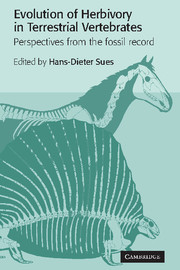Book contents
- Frontmatter
- Contents
- List of contributors
- Preface
- 1 Herbivory in terrestrial vertebrates: an introduction
- 2 Herbivory in late Paleozoic and Triassic terrestrial vertebrates
- 3 Prosauropod dinosaurs and iguanas: speculations on the diets of extinct reptiles
- 4 The evolution of sauropod feeding mechanisms
- 5 Plant-eaters and ghost lineages: dinosaurian herbivory revisited
- 6 Dental constraints in the early evolution of mammalian herbivory
- 7 Patterns in the evolution of herbivory in large terrestrial mammals: the Paleogene of North America
- 8 Origin and evolution of the grazing guild in Cenozoic New World terrestrial mammals
- Taxonomic index
- Subject index
2 - Herbivory in late Paleozoic and Triassic terrestrial vertebrates
Published online by Cambridge University Press: 22 October 2009
- Frontmatter
- Contents
- List of contributors
- Preface
- 1 Herbivory in terrestrial vertebrates: an introduction
- 2 Herbivory in late Paleozoic and Triassic terrestrial vertebrates
- 3 Prosauropod dinosaurs and iguanas: speculations on the diets of extinct reptiles
- 4 The evolution of sauropod feeding mechanisms
- 5 Plant-eaters and ghost lineages: dinosaurian herbivory revisited
- 6 Dental constraints in the early evolution of mammalian herbivory
- 7 Patterns in the evolution of herbivory in large terrestrial mammals: the Paleogene of North America
- 8 Origin and evolution of the grazing guild in Cenozoic New World terrestrial mammals
- Taxonomic index
- Subject index
Summary
Introduction
The exploitation of land plants as a major food resource by amniote tetrapods led to profound changes in the pattern of trophic interactions in terrestrial ecosystems during the late Paleozoic (Olson 1961, 1966; King 1996; Hotton et al. 1997; Sues and Reisz 1998). Prior to the appearance of various forms specialized for feeding on plants, tetrapods could access the plentiful vegetal resources only indirectly through detritivory and consumption of invertebrates that fed on plants and/or plant detritus (Olson 1961, 1966). The oldest plant-eating tetrapods are known from the Late Pennsylvanian (Late Carboniferous) of North America and Europe. However, herbivores did not form a major component of the known terrestrial tetrapod assemblages from the Early Permian. Only during the Late Permian, some 40 million years after their first appearance, did plant-eating tetrapods become abundant and much diversified in the fossil record. At that time, a ‘modern’ pattern of trophic interactions was established, with a vast standing crop of herbivores sustaining a relatively small number of top carnivores. Communities of this type are first documented by diverse assemblages of tetrapods from the Late Permian portion of the Beaufort Group of South Africa (Kitching 1977) and, to a lesser extent, from more or less coeval continental strata in other regions of the world.
Morphological and physiological correlates of herbivory
The effective utilization of high-fiber plant material by vertebrates requires two steps. First, the plant material must be mechanically broken up by oral processing or by comminution in a muscular gizzard using ingested grit and pebbles. Present-day herbivorous lizards do not chew their food (Throckmorton 1976), and leaves often pass through the gastrointestinal tract virtually intact (Bjorndal 1979; Iverson 1982).
- Type
- Chapter
- Information
- Evolution of Herbivory in Terrestrial VertebratesPerspectives from the Fossil Record, pp. 9 - 41Publisher: Cambridge University PressPrint publication year: 2000
- 80
- Cited by



